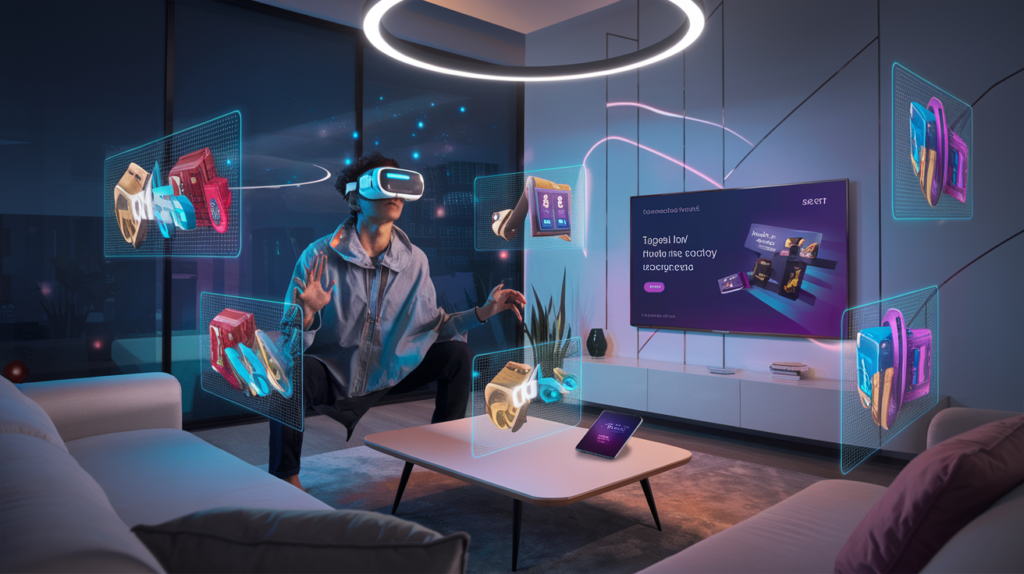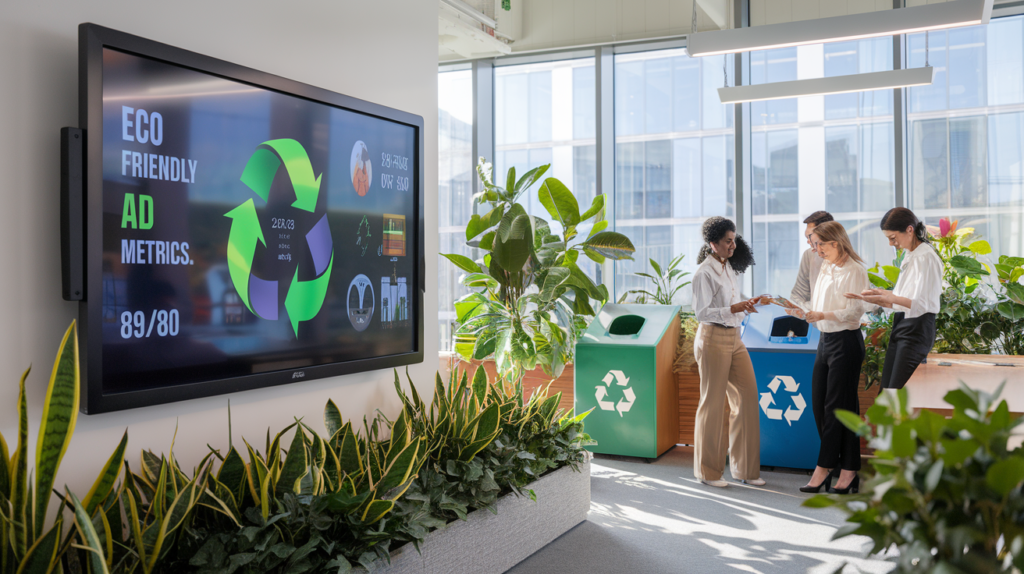Creating Localized Content
Creating Localized Content
Table of Contents
🚀 Are you ready to catapult your digital advertising strategy into the future? Buckle up, because the landscape is evolving at warp speed, and what worked yesterday might not cut it tomorrow. As we hurtle towards 2025, the digital advertising realm is undergoing a seismic shift, leaving many marketers scrambling to keep up.
But here’s the burning question: Are you prepared for the revolution? From immersive technologies that blur the lines between reality and virtual worlds to voice-activated ads that literally speak to your audience, the future of digital advertising is both thrilling and challenging. And let’s not forget the looming specters of privacy concerns and sustainability imperatives that are reshaping how we connect with consumers.
In this deep dive, we’ll explore six game-changing trends that are set to dominate the digital advertising landscape by 2025. From cutting-edge tech to ethical considerations, we’ll unpack everything you need to know to stay ahead of the curve and make your mark in this brave new world of advertising. So, are you ready to glimpse into the crystal ball and future-proof your strategy? Let’s begin! 👀💡
Immersive Technologies in Advertising

Virtual reality (VR) ad experiences
Virtual reality is set to revolutionize digital advertising by 2025, offering unprecedented levels of immersion and engagement. Brands will create fully interactive 3D environments where consumers can explore products and services in lifelike detail. These VR ad experiences will transport users to virtual showrooms, test drives, and even fantasy worlds aligned with brand identities.
VR Ad Format | Description | Engagement Level |
360° Videos | Immersive brand storytelling | High |
Interactive Demos | Hands-on product exploration | Very High |
Virtual Events | Exclusive brand experiences | Extremely High |
Augmented reality (AR) product demonstrations
AR will bridge the gap between digital and physical worlds, allowing consumers to visualize products in their own environment. This technology will be particularly impactful for:
- Furniture and home decor
- Cosmetics and fashion
- Automotive industry
- Electronics and gadgets
Mixed reality (MR) brand interactions
Mixed reality will combine elements of both VR and AR, creating hybrid experiences that seamlessly blend digital content with the physical world. Brands will use MR to:
- Provide interactive product guides
- Offer personalized shopping assistants
- Create gamified brand experiences
- Enhance in-store navigation and product information
Optimizing Your Google My Business Listing

Smart speaker ad integration
As voice-activated devices become increasingly prevalent in homes, smart speaker ad integration is poised to revolutionize digital advertising. Brands are exploring innovative ways to leverage these platforms for targeted and non-intrusive advertising experiences.
- Key advantages of smart speaker ad integration:
- Contextual relevance
- Personalized recommendations
- Seamless user experience
- Enhanced brand engagement
- Contextual relevance
Platform | Ad Format | User Interaction |
Amazon Alexa | Sponsored voice responses | “Alexa, what’s the best coffee maker?” |
Google Home | Voice-activated promotions | “Hey Google, tell me about nearby dinner deals” |
Apple HomePod | Audio content sponsorships | “Siri, play the latest episode of [sponsored podcast]” |
Voice search optimization
With the rise of voice-activated searches, optimizing content for voice queries is becoming crucial for digital advertisers. This involves adapting SEO strategies to accommodate natural language patterns and conversational queries.
Voice-activated purchasing
Voice-activated purchasing is set to transform e-commerce by offering a frictionless shopping experience. Advertisers are developing voice-specific campaigns that guide users through the purchasing funnel using only voice commands.
- Steps to implement voice-activated purchasing:
- Optimize product listings for voice search
- Create voice-friendly checkout processes
- Develop voice-specific promotional offers
- Implement voice authentication for secure transactions
- Optimize product listings for voice search
As we move towards more intuitive and hands-free interactions, the next frontier in digital advertising lies in creating unified experiences across various platforms and devices.
Privacy-Centric Advertising Models

Cookieless tracking alternatives
As privacy concerns grow, advertisers are exploring innovative ways to track user behavior without relying on third-party cookies. Some promising alternatives include:
- Contextual advertising
- Federated learning
- Device fingerprinting
- Universal IDs
Method | Description | Privacy Level |
Contextual | Targets ads based on content, not user data | High |
Federated learning | Machine learning on decentralized data | High |
Device fingerprinting | Identifies devices using unique attributes | Medium |
Universal IDs | Single identifier across multiple platforms | Medium |
Blockchain for transparent ad transactions
Blockchain technology is revolutionizing ad transparency and fraud prevention. Key benefits include:
- Immutable record-keeping
- Real-time verification of ad impressions
- Elimination of intermediaries
- Secure and transparent payments
Zero-party data collection strategies
Brands are increasingly focusing on zero-party data – information voluntarily shared by consumers. Effective collection methods include:
- Interactive quizzes and surveys
- Preference centers
- Gamified experiences
- Loyalty programs
Privacy-enhancing technologies (PETs)
PETs are emerging as crucial tools for maintaining user privacy while still enabling effective advertising. Some notable PETs include:
- Differential privacy
- Homomorphic encryption
- Secure multi-party computation
- Trusted execution environments
These technologies allow for data analysis and targeting without exposing individual user information, striking a balance between personalization and privacy protection.
As we move towards more privacy-centric advertising models, the industry will need to adapt quickly to these new technologies and strategies. Next, we’ll explore how advertisers are creating unified experiences across multiple platforms to engage consumers more effectively.
Cross-Platform Unified Experiences

Seamless omnichannel advertising
In 2025, brands will focus on creating unified experiences across multiple platforms, ensuring a cohesive customer journey. This approach will involve:
- Consistent messaging across devices
- Personalized content based on user behavior
- Real-time data synchronization
Connected TV and streaming ad integration
As streaming services continue to dominate, advertisers will leverage advanced targeting capabilities:
Feature | Benefit |
Interactive ads | Higher engagement rates |
Dynamic ad insertion | Personalized viewing experiences |
Addressable TV advertising | Precise audience targeting |
In-game advertising advancements
Gaming will become a prime advertising space, offering:
- Native in-game product placements
- Reward-based ad experiences
- Virtual billboards and sponsored events
Social commerce and shoppable ads
Social media platforms will evolve into robust e-commerce channels:
- One-click purchasing within social apps
- AR-powered virtual try-ons
- Influencer-driven shoppable content
Data-Driven Creative Optimization

Real-time ad performance analysis
Real-time ad performance analysis is revolutionizing the way advertisers optimize their campaigns. By leveraging advanced analytics tools and AI-powered algorithms, marketers can now gain instant insights into their ad performance across multiple platforms. This enables them to make data-driven decisions and adjust their strategies on the fly.
Key benefits of real-time analysis:
- Immediate optimization opportunities
- Reduced ad spend waste
- Improved ROI
- Enhanced audience targeting
Metric | Traditional Analysis | Real-time Analysis |
Speed | Hours to days | Seconds to minutes |
Accuracy | Moderate | High |
Actionability | Limited | Immediate |
Emotional response tracking
Emotional response tracking is taking personalized advertising to new heights. By utilizing advanced biometric sensors and AI-powered facial recognition, advertisers can now gauge the emotional impact of their ads in real-time. This technology allows for the creation of more engaging and resonant content that truly connects with the audience on an emotional level.
Multivariate testing at scale
Multivariate testing at scale is empowering advertisers to optimize their creative elements with unprecedented precision. By simultaneously testing multiple variables such as headlines, images, colors, and call-to-actions, marketers can identify the most effective combinations for different audience segments. This data-driven approach ensures that every element of an ad is fine-tuned for maximum impact and conversion rates.
With these advancements in data-driven creative optimization, advertisers are now better equipped to deliver highly personalized and effective ad experiences. As we move towards 2025, the integration of these technologies will be crucial for staying competitive in the digital advertising landscape.
Sustainability in Digital Advertising

Carbon-neutral ad campaigns
As sustainability becomes a key focus for businesses, carbon-neutral ad campaigns are gaining traction. These campaigns aim to minimize or offset their environmental impact through various strategies:
- Efficient ad delivery systems
- Use of renewable energy for ad servers
- Carbon offsetting for digital ad operations
Strategy | Description | Impact |
Efficient delivery | Optimize ad serving algorithms | Reduces energy consumption |
Renewable energy | Power ad servers with clean energy | Lowers carbon footprint |
Carbon offsetting | Invest in environmental projects | Neutralizes remaining emissions |
Eco-friendly ad formats
Advertisers are developing innovative, eco-friendly ad formats that reduce digital waste and energy consumption:
- Lightweight ad creatives
- Low-bandwidth video ads
- Static image ads with minimal animation
These formats not only decrease the environmental impact but also improve load times and user experience.
Sustainability messaging integration
Brands are increasingly incorporating sustainability messages into their digital ads:
- Highlighting eco-friendly products or services
- Showcasing corporate sustainability initiatives
- Educating consumers on environmental issues
This approach not only promotes sustainable practices but also resonates with environmentally conscious consumers.
Green programmatic solutions
Programmatic advertising is evolving to include green solutions:
- AI-powered optimization for energy-efficient ad placements
- Blockchain technology for transparent and efficient ad transactions
- Green DSPs (Demand-Side Platforms) prioritizing sustainable inventory
These innovations are paving the way for a more sustainable digital advertising ecosystem. As we move forward, the integration of sustainability in digital advertising will likely become a standard practice rather than an exception.
The digital advertising landscape is poised for significant transformation by 2025. Immersive technologies, voice-based interactions, and privacy-centric models will reshape how brands connect with consumers. Advertisers will need to create seamless experiences across platforms while leveraging data-driven insights to optimize their creative content. Additionally, sustainability will play a crucial role in shaping advertising strategies and consumer perceptions.
As we look towards the future, marketers and advertisers must stay ahead of these trends to remain competitive. Embracing new technologies, prioritizing user privacy, and focusing on sustainable practices will be key to success in the evolving digital advertising ecosystem. By adapting to these changes and continuously innovating, brands can create more engaging, personalized, and effective advertising campaigns that resonate with their target audiences in the years to come.
🚀 The future of digital advertising is evolving rapidly! Stay ahead by understanding the key trends shaping 2025. At Viral Groww, we help businesses navigate the latest advancements to maximize reach and engagement.
📈 From AI-driven ad personalization to privacy-focused marketing, we identify and implement cutting-edge strategies—so you achieve better targeting, higher conversions, and stronger brand impact.
📩 Contact us today and let’s future-proof your digital advertising strategy for success! 🚀
Immersive technologies like AR, VR, and MR will create interactive ad experiences, allowing users to engage with products in virtual showrooms and gamified ads.
Privacy-friendly solutions like contextual advertising, universal IDs, and federated learning help brands target users effectively while complying with data protection laws.
Brands will adopt carbon-neutral campaigns, energy-efficient ad servers, and eco-friendly messaging to attract conscious consumers and reduce their environmental footprint.
Real-time data analysis helps brands track performance, adjust campaigns instantly, and maximize ROI using AI-driven insights and predictive analytics.

How We 2.5X’d Organic Traffic for SUYU India in Just 5 Months by Following Our White Hat SEO Framework
SUYU India was born with a clear vision—to bring superfood-powered skincare into the Indian market. Co-founded with a deep belief in sustainability.

Scaling a Sexual Wellness Brand with SEO – How We Did It for Ecstasia
Ecstasia is a sexual wellness D2C brand started by Prakhar Raj and Hamid Iqbal in December 2024. Prakhar, a school friend of mine, works in a corporate job but has always wanted to start his own business.

How we got 8.7X Impressions for a gifting D2C brand within 3 Months by doing White Hat SEO
Foundation Gift was started by Rakesh Adak and Abhishek Koley with a simple idea — gifts should feel just as special as the moments they celebrate.

Scaling a Lingerie Brand to 7-Figure Sales in Just 75 Days—Proof Inside!
Krvvy is a modern, forward-thinking lingerie brand committed to redefining comfort and functionality. Designed to elevate the lingerie experience, Krvvy celebrates the beauty of all women, embracing and admiring every curve.

How Sumit Dubey Fitness Classes Transformed into a Fitness Empire with Strategic Digital Marketing
Sumit Dubey Fitness Classes, founded by Sumit Dubey, provides online fitness training with a personalized touch.

Raj Yoga School’s Journey to the Top of Search Rankings
Nestled between the tranquil peaks of the Himalayas and the sun-kissed beaches of Goa, Raj Yoga School has been a sanctuary for aspiring yoga teachers in India.

Scaling Dharishah Ayurveda from ₹20 Lakhs to ₹50 Lakhs in Monthly Sales
Dharishah Ayurveda, a promising Ayurvedic brand, had already seen growth through performance marketing, scaling from ₹2 lakhs to ₹20 lakhs in monthly sales (covered in a previous case study).

Building Trust and Revenue for Dharishah Ayurveda with Scalable Facebook Ads
Dharishah Ayurveda, led by CEO Naman Dhamija, is a premium Ayurvedic brand dedicated to promoting natural wellness.

How Goyal Packers & Movers Skyrocketed to #1 in 40+ Cities with White Hat SEO
Goyal Packers and Movers India, owned by Mr. Sampat Singh, is one of the most preferred packers and movers across Northern India, offering exceptional shifting services.





